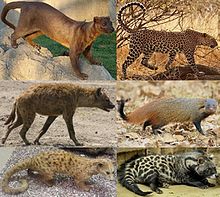
Back Feliformia Afrikaans Feliformia AN سنوريات الشكل Arabic سنوريات الشكل ARY سنوريات الشكل ARZ Pişikkimilər Azerbaijani پیشیک کیمیلر AZB Feliformia BAN Коткападобныя BE-X-OLD Коткоподобни Bulgarian
| Feliforms Temporal range: Middle Eocene-Holocene
| |
|---|---|

| |
| Clockwise from top-left: fossa (family Eupleridae), leopard (family Felidae), stripe-necked mongoose (family Herpestidae), African civet (family Viverridae), two-spotted palm civet (family Nandiniidae), spotted hyena (family Hyaenidae) | |
| Scientific classification | |
| Domain: | Eukaryota |
| Kingdom: | Animalia |
| Phylum: | Chordata |
| Class: | Mammalia |
| Order: | Carnivora |
| Suborder: | Feliformia Kretzoi, 1945 |
| Families | |
| |
Feliformia is a suborder within the order Carnivora consisting of "cat-like" carnivorans, including cats (large and small), hyenas, mongooses, viverrids, and related taxa. Feliformia stands in contrast to the other suborder of Carnivora, Caniformia consisting of "dog-like" carnivorans (includes Canoidea).[1]
The separation of the Carnivora into the broad groups of feliforms and caniforms is widely accepted, as is the definition of Feliformia and Caniformia as suborders (sometimes superfamilies). The classification of feliforms as part of the Feliformia suborder or under separate groupings continues to evolve.
Systematic classifications dealing with only extant taxa include all feliforms into the Feliformia suborder, though variations exist in the definition and grouping of families and genera.[2][3] Indeed, molecular phylogenies suggest that all extant Feliformia are monophyletic.[4]
Systematic classifications dealing with both extant and extinct taxa vary more widely.[5][6] Some separate the feliforms (extant and extinct) as Aeluroidea (superfamily) and Feliformia (suborder).[6] Others include all feliforms (extant, extinct and "possible ancestors") into the Feliformia suborder.[5] Some studies suggest this inclusion of "possible ancestors" into Feliformia (or even Carnivora) may be spurious.[7] The extinct (†) families as reflected in the taxa chart are the least problematic in terms of their relationship with extant feliforms (with the most problematic being Nimravidae).
- ^ Basic Biology (2015). "Carnivora".
- ^ Taxonomic references - extant species (1): Supporting descriptive information and pictures: Diversity Web (online) – Feliformia
- ^ Taxonomic references - extant species (2): Integrated Taxonomic Information System (ITIS)
- ^ Eizirik, E., W.J. Murphy, K.P. Koepfli, W.E. Johnson, J.W. Dragoo, R.K.Wayne, en S.J. O’Brien, 2010. Pattern and timing of the diversification of the mammalian order Carnivora inferred from multiple nuclear gene sequences. Molecular Phylogenetics and Evolution 56: 49-63. doi:10.1016/j.ympev.2010.01.033
- ^ a b Fossil record data (with taxonomic references) extant and extinct species: The Paleaobiology Database
- ^ a b Supporting taxonomic references extant and extinct species: Systema Naturae 2000 / Classification - Suborder Feliformia Archived 2007-09-26 at the Wayback Machine
- ^ Wesley-Hunt, Gina D.; Flynn, John J. (2005). "Phylogeny of the carnivora: Basal relationships among the carnivoramorphans, and assessment of the position of 'miacoidea' relative to carnivora". Journal of Systematic Palaeontology. 3 (1): 1–28. doi:10.1017/S1477201904001518. ISSN 1477-2019. S2CID 86755875.